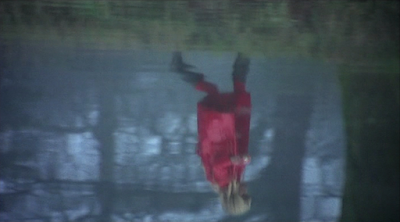At this point, Shirley Jackson's story is your basic stone classic—of horror, of short stories, of midcentury literature. For spoiler-phobes who haven't read it, I'm talking about everything here. According to legend (and Wikipedia), no story or article published by
The New Yorker has ever received as much mail from readers—some concerned the story was factual reporting, some thinking it was reporting and wanting to know where they could go watch. But most, quite reasonably, inquiring into just what in the hell was going on around here. By the methodology used at
Make Lists, Not War, "The Lottery" is the highest-ranked short story of all time, tied with D.H. Lawrence's "The Rocking-Horse Winner" (which, in case anyone was wondering, is the Lawrence story misplaced in
The Dark Descent). It's not hard to see the reason for the brouhaha. The story is crisp, straightforward, and quick to the point, yet bottomlessly mysterious, with no explanations. In fact, a good many of those letters to
The New Yorker and/or Jackson were exactly requests for explanations. To me, its popularity (or notoriety) is equally surprising and mysterious, emerging sideways out of the horror genre (
The New Yorker known for many things but horror not one of them), banked as it is with such superhot stores of blind cruel rage they are practically explanatory in themselves. I get a similar charge from the more current
Purge franchise of movies, which also rely on a similar outrageous yet believable enough ritual. Further enlightenment on what this story unleashes may also be found in the end of director Peter Jackson's movie from the '90s,
Heavenly Creatures.
The explanation, which ironically satisfies no one, is catharsis. Let's think about that one because it's one of those things that always seems fuzzy, even at dictionary level. Merriam-Webster, for example, puts "catharsis" squarely in the realm of art, with its 1-a definition—"purification or purgation of the emotions (such as pity and fear) primarily through art"—but I think the Oxford spin actually applies more directly here: "the process of releasing, and thereby providing relief from, strong or repressed emotions." That seems to be an explanation, at least for the lottery within Jackson's story. But I'm not sure it explains the story "The Lottery" itself, why it exists in the world or its effect on us. As with
The Purge—and resembling Scott McCloud's space between the panels in comic book narrative—a lot of the power of "The Lottery" is derived from trying to imagine how we got from here to there. Why June 27, for example? What does that commemorate? We can guess Jackson's intent as the writer, using the solstice associations of that time of year with ancient rituals, sacrifices, and festivals. The "purge" in the movies is set similarly on the spring equinox, the night of March 21. Both imply surging life and bloody rites of spring. But how, within the story of "The Lottery," did this shockingly barbaric ritual—stoning!—come to pass? No explanation. Why do they do it at all? No explanation.
The Purge movies offer some extreme right-wing Christian patriot mumbo-jumbo justifications, which may not weaken them as a whole but plainly is where they depart from "The Lottery."
"The Lottery" makes you answer those questions for yourself, or give up and write them down and mail them to
The New Yorker or Jackson (who died in 1965 at the age of 48). The story is full of great effects, mostly working like some sunny day afternoon John Cheever story. This so-called village could as well have been named Any Town Suburb USA, it is intended to be so white-majority generic, with its families named Watson and Martin and Delacroix and Hutchinson. The people are brave and everyone is kind. The ritual has been deeply impressed into the fabric of their lives. It simply exists without question. As with public exhibitions of lynchings and executions in the US past, a number of sadists may be seen nibbling at the edges, there for the sick kicks. Mostly it seems to be ordinary people on a busy weekend but the details can be telling. Much is revealed in small actions by these people, e.g., Mrs. Delacroix, who lifts "a stone so large she had to pick it up with both hands." After the victim has been selected, in a murky process, the official in charge lets the townspeople loose with a word: "All right, folks. Let's finish quickly." It is a nearly perfect balance between a suburban daydream and a sickeningly barbaric violation. Stoning is perfect. Hanging would not be enough. Crucifixion would be too much. Jackson's precision is amazing at every point of this story. We are shocked, benumbed, that its events are even happening at all, so swiftly do they come.
Shirley Jackson, Novels and Stories (Library of America)Read story online.
















